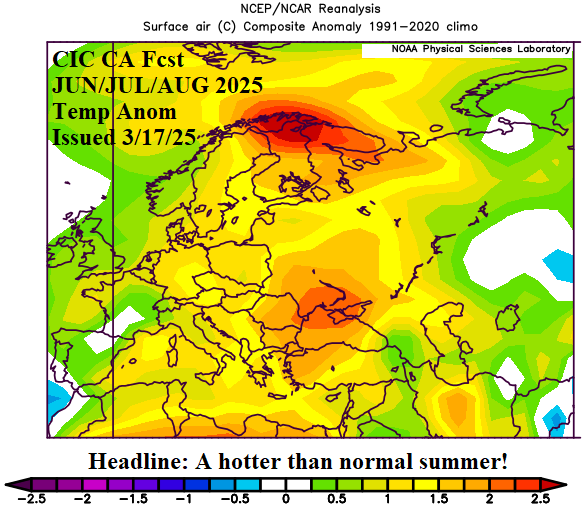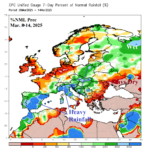
Marine Heatwaves Influence on Europe Climate
03/16/2025, 9:32 am EDT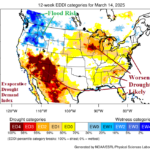
Focused on Dry/Drought Threat in U.S.
03/19/2025, 8:35 am EDTExecutive Summary: The Climate Impact Company month 1-5 ahead climate forecast for Europe and Western Russia valid for April through July is updated. The primary concern is whether presence of dry-to-drought conditions across the eastern half of Europe to Southwest Russia and the Black Sea region will worsen mid-to-late spring and summer. The outlooks support intensification as the presence of upper-level ridging to warm and dry this region is well-supported by the correlating SSTA forecasts. During Q2/2025 the outlook is warm and mostly drier than normal from Northern Europe to the Black Sea region (Fig. 1-2). Wet weather lingers across Southwest Europe. Northwest Russia turns cool and wet. Meteorological summer 2025 brings widespread anomalous warmth and mostly dry climate from Western Europe to the Black Sea region encouraging drought expansion (Fig. 3-4).
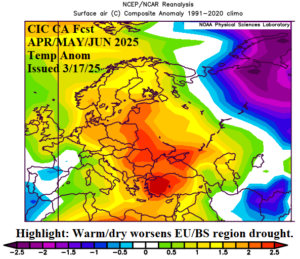
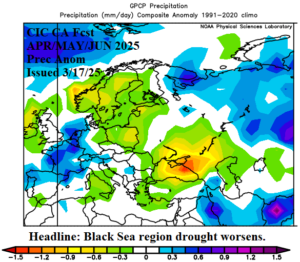
Fig. 1-2: The Climate Impact Company temperature and precipitation forecast for Europe and Western Russia during APR/MAY/JUN 2025.
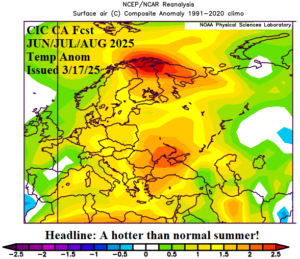
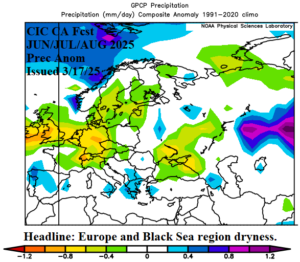
Fig. 3-4: The Climate Impact Company temperature and precipitation forecast for Europe and Western Russia during JUN/JUL/AUG 2025.
Climate: The Europe/Western Russia month 1-5 forecast is primarily driven by several oceanic features. First, and most immediately prominent, is the ongoing marine heatwave (MHW) across the Mediterranean Sea. The basin SSTA is consistently in the +1.5C to +1.8C range which is historically warm. The warm bias is tilted toward the eastern basin which continues to warm during recent weeks. Aloft the atmosphere responds by a persistent upper-level ridge which helps to dry and warm the Black Sea region (and vicinity) during Q2/2025 followed by ridge expansion northward during summertime maintaining anomalous warmth and dry risk. The presence of the ridge pattern has ignited dry soil conditions in the Black Sea region to Eastern Europe and that relationship is (mostly) maintained through summertime. The MHW off the west and south coast of Europe is weakening lately due to the semi-permanent upper trough near Southwest Europe. During late spring and summer, the MHW should regain strength and the upper low shifts to the North Atlantic warm hole (NAWH) prominently forecast to emerge south of Greenland during the warm season. If so, the downstream influence of the upper trough over the NAWH should be an upper ridge over Europe further enhancing dry and warm conditions. The regional SSTA forecast offers excellent support for the expansion of Europe to the Black Sea region drought for summer 2025. Further downstream, an upper trough develops for Q2/2025 in Northwest Russia fading as meteorological summer arrives. The NAWH and MHW’s off west and southwest Europe plus the Mediterranean Sea MHW play dominant roles in the EU/RU climate pattern ahead.
April 2025: The influence of the warm Mediterranean Sea on the upper air pattern favors upper-level high-pressure ridging likely to produce a warmer and drier than normal mid-spring across Southern Europe to the Black Sea region with a streak of wet weather to the north stretching from U.K. to Northwest Russia. Forecast confidence is below average on where the streak of wet weather aligns, a slightly farther south location is possible.
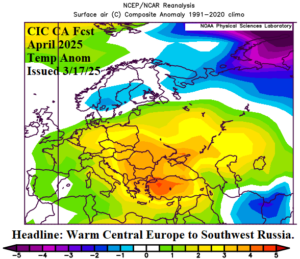
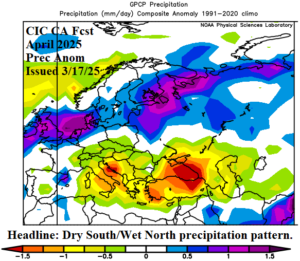
Fig. 5-6: The Climate Impact Company temperature and precipitation forecast for Europe and Western Russia during April 2025.
May 2025: During late spring the upper ridge across the Western Mediterranean Sea northward to the Black Sea region may extend farther northward. Dryness and anomalous warmth is displaced farther north into Northern Europe. A downstream compensating cool and wet trough emerges in West-central Russia. The persistent upper low bringing wet weather to Southwest Europe remains.
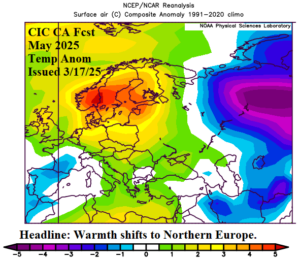
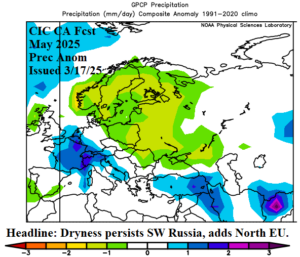
Fig. 7-8: The Climate Impact Company temperature and precipitation forecast for Europe and Western Russia during May 2025.
June 2025: The beginning of meteorological summer 2025 favors anomalous warmth across all of Europe (except the Southwest) stretching to Southwest Russia and turkey. The precipitation forecast is mixed as dryness emerges from U.K. to the Baltic Region while occasional upper troughs bring rain to Southeast Europe to Western Russia. The immediate Black Sea region stays drier than normal. West-central Russia is wetter than normal. Additional rains are likely for Portugal to Western France.
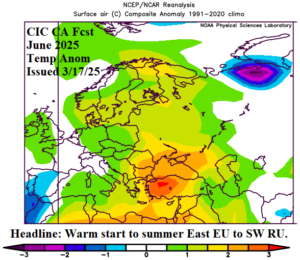
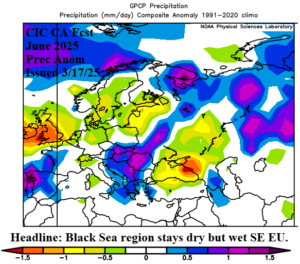
Fig. 13-16: The preliminary Climate Impact Company temperature and precipitation forecast for Europe and Western Russia during June 2025.
July 2025: During mid-summer, the outlook indicates anomalous heat across the core of the drought area across Central Europe to the Black Sea region. However, mid-summer thunderstorm activity is prominent and can suppress drought in a few areas. Usually, mid-summer thunderstorms have limited effect on defeating established drought. Dryness shifts to Central Europe during mid-summer.
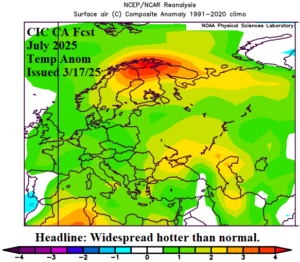
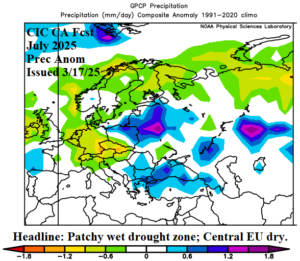
Fig. 17-20: The Climate Impact Company temperature and precipitation forecast for Europe and Western Russia during July 2025. Previous below.
August 2025: The late summer forecast is aggressively warmer than normal across most of Europe to Western Russia. A drier than normal climate extends from Central Europe to Southwest Russia as drought in that region will worsen.
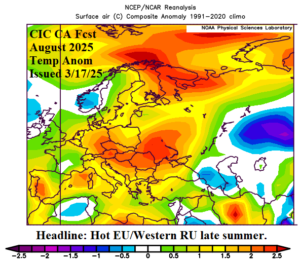
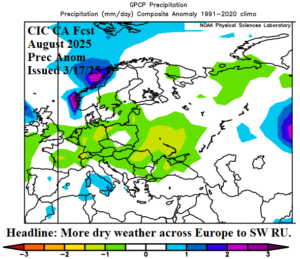
Fig. 21-22: The preliminary Climate Impact Company temperature and precipitation forecast for Europe and Western Russia during August 2025.

